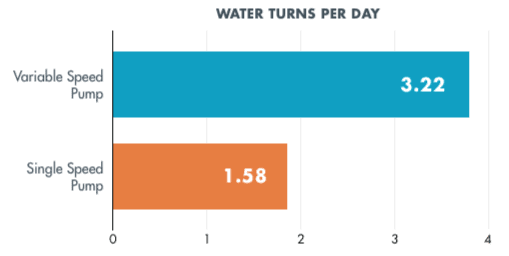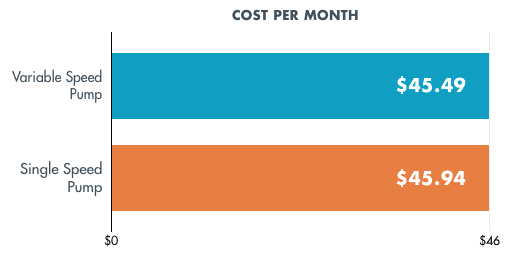Good circulation is crucial to properly maintaining a pool, which is why a variable speed pump can be one of your best pool investments.
Circulation ties directly into the pump operation; mainly the flow rate of the water and time of circulation. In addition, the more times your water turns over in a day — how many times the full volume of water in the pool passes through the circulation system — the better the pool the circulation will be.
There are two main types of pumps in the pool space, single speed and variable speed pumps. The difference between the two is that variable speed pumps allow you to adjust the flow rate of water through the circulation system, while single speed pumps only have one speed. Typically this single speed correlates to the max operating speed of variable speed pumps.
With a variable speed pump a pool owner can circulate their water at lower flow rates for a more prolonged period of the day without added energy consumption. This study by the National Renewable Energy Laboratory confirms that variable speed pumps are significantly more energy efficient than single speed pumps.
For a quick comparison, let’s compare the energy cost of a single speed pump running for 8 hours a day at 3450 rpm, to a variable speed pump running for 24 hours a day at 2400 rpm.




No matter what type of pool sanitation the pool is using, I will always recommend continuous (24 hour circulation) for three reasons:
1. It helps to prevent stagnant water that algae and bacteria like to grow in.
2. It helps to promote filtration, which removes big particulates that bacteria and algae like to grow on and eat.
3. It allows the sanitation system to treat the water more often which is crucial for UV, ozone and our Clear Comfort systems. Furthermore, it is beneficial for salt systems because you are able to turn the salt production down which reduces the wear and tear on the salt cell. It is also helpful for chlorine/bromine injectors and tab feeders because you are also able to introduce less sanitizer which will allow for a more stable sanitizer concentration in your pool.
Although single speed pumps are a bit cheaper than a variable speed pump, the benefits of water turnover, extended filtration and prolonged sanitation times will make maintaining your pool easier. Furthermore, the energy savings that a variable speed pump offers over a single speed pump will pay for the initial price difference within several years. So here is my question to you: Why would you settle for a pump that can only do half the job that a variable speed pump can do?





